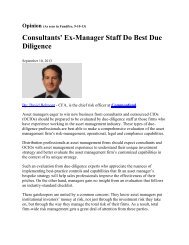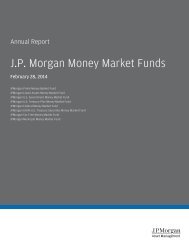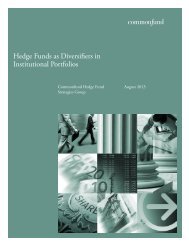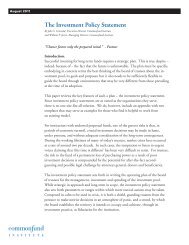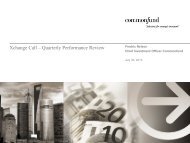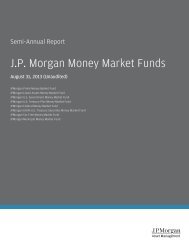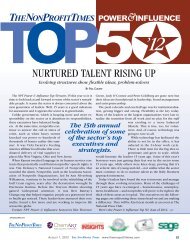Principles of Nonprofit Investment Management - Commonfund
Principles of Nonprofit Investment Management - Commonfund
Principles of Nonprofit Investment Management - Commonfund
You also want an ePaper? Increase the reach of your titles
YUMPU automatically turns print PDFs into web optimized ePapers that Google loves.
Asset AllocationIn the fast-moving world <strong>of</strong> nonpr<strong>of</strong>its,where investment returns can be socrucial, a detailed point <strong>of</strong> view aboutthe trends in the economy and marketsis essential.For all the information and analytictools used to guide decision makers,the asset allocation decision stillremains difficult; it involves more thannumbers. For nonpr<strong>of</strong>its, this decisionmust embody the philanthropic missionand perhaps deeply held feelings<strong>of</strong> founders and members <strong>of</strong> governingboards, their risk tolerance, their sense<strong>of</strong> the nonpr<strong>of</strong>it’s time horizon, andany number <strong>of</strong> policy issues that cannotbe expressed in numbers alone.Private nonpr<strong>of</strong>its, established on thestock <strong>of</strong> the founder’s company, remainin a highly risky predicament untilthe portfolio can be diversified. Thatin itself needs careful planning –assuming that liquidation is allowed.In any scenario, the determination<strong>of</strong> the asset allocation target must becarried out in a disciplined manner. Atthe outset, the investment committee,or the full board, ought to agree ona moderator and an agenda for thediscussion. Every member should havethe opportunity to express his or herconcerns and expectations. Allow eachone to propose the level <strong>of</strong> risk he orshe considers tolerable.In writing its investment policy statement,the committee should includea rationale for the asset allocation onwhich it has decided. A brief, wellstatedexplanation could help achievethe concurrence <strong>of</strong> the full board andfounder or founding family and helpguide portfolio managers in implementinginvestment strategy.In time, as markets change, theportfolio’s actual asset allocation willdeviate from the targets set down inthe policy statement. This is a naturalconsequence <strong>of</strong> the markets grantinghigher returns to certain asset classesthan to others. Therefore, adjustmentsmust be made on a regular basis.The theory underlying asset allocationstrategy prescribes periodic rebalancingto bring the portfolio back into targetedranges. This means sellingsome <strong>of</strong> the appreciated assets andreinvesting the proceeds in assetcategories that have declined.For the inexperienced, selling successfulinvestments may seem counterto long-held beliefs. But, looked atanother way, it forces action that getsto the very essence <strong>of</strong> successful investing– buying cheap and selling dear.The investment committee mustmaintain oversight <strong>of</strong> the portfoliothrough all the cycles <strong>of</strong> the investmentmarkets. But for implementation <strong>of</strong>its asset allocation policy it employspr<strong>of</strong>essional investment managers.And that is the subject <strong>of</strong> the nextsection, under Principle Four.- 19 -



